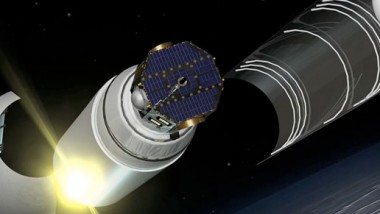The European Space Agency (ESA) and its partners (including NASA) are preparing to launch the Herschel Space Observatory into space. Formerly named the Far Infrared and Submillimetre Telescope (FIRST), Herschel will observe the far infrared and submillimeter wavelengths from stable ...
Diamond-Like Carbon Films Used in IBEX
Scientists at Sandia National Laboratory in New Mexico have created diamond-like thin carbon films which have now been used in the low energy sensors of the recently launched NASA Interstellar Boundary Explorer (IBEX). The smooth layer of film efficiently ionizes ...
Carbon Dioxide…in Space?
Carbon dioxide has been discovered by the Hubble Space Telescope in the atmosphere of a planet orbiting another star. The discovery, which was recently announced by NASA is, according to the agency, an important step towards finding chemical biotracers of ...
Ares Super-Chute Tests
NASA and the United States Air Force have successfully tested a new super-chute system aimed at reclaiming reusable Ares booster rockets. On February 28, 2009 a 50,000 pound dummy rocket booster was dropped in the Arizona desert and stopped by ...
NASA’s Kepler Telescope Launched Successfully
At precisely 10:49 p.m. EST, NASA’s “Kepler” telescope was successfully kicked off into space, embarking on a mission that the agency says “may fundamentally change humanity’s view of itself.” The telescope will search the nearby region of our galaxy for ...
The Orbital Menace – Space Garbage
We have all heard about the challenges and dangers involved in space travel. Even though the space shuttle is equipped with the finest technology money can buy, and staffed with the best and most highly trained astronauts, nobody can guarantee ...
CECE Engine Passes Third Round of Tests
Pratt & Whitney Rocketdyne, of West Palm Beach, Florida has successfully completed the third round of its Common Extensible Cryogenic Engine (CECE) testing for the National Aeronautics and Space Administration (NASA). CECE is a new deep throttling engine designed to ...
Cosmic Rays from Nowhere
A mysterious object close to our solar system was detected by an international team of researchers who made the discovery after exploring an unusual surplus of high-energy electrons bombarding the Earth from outer space. While there is nothing unusual in ...
Energy-Harvesting Radios
Engineers from Kansas State University (KSU), in collaboration with the San Diego-based integrated circuit manufacturer “Peregrine Semiconductor” are set to develop an energy-harvesting radio, which would be able to continuously transmit data without ever requiring a change of batteries. Professor ...
NASA eClips
The National Aeronautics and Space Agency is posting a variety of science, technology, engineering, and mathematics (STEM) educational videos freely available for use in the classroom or home environment. Called “NASA eClips,” the program provides short videos for different age ...









